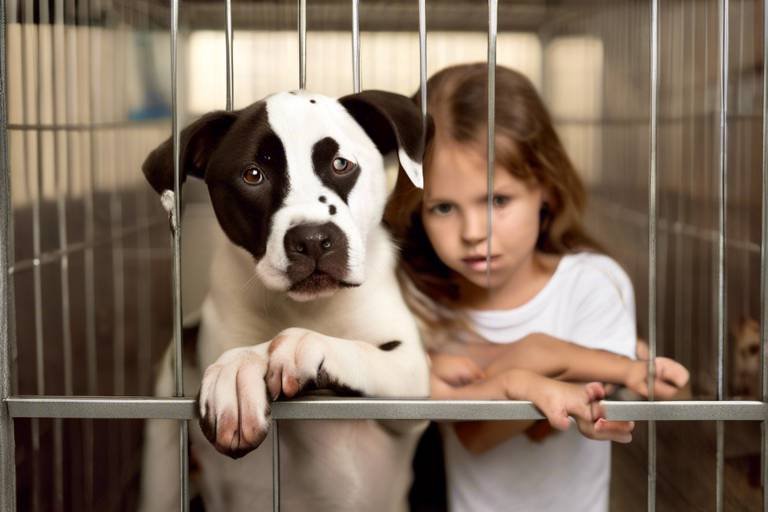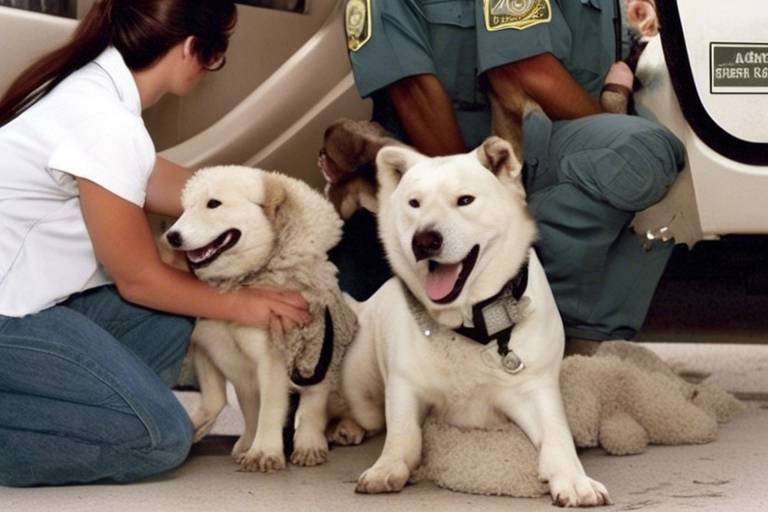How to Help Your Pet Overcome Past Trauma
When it comes to our furry friends, their emotional well-being is just as important as their physical health. If your pet has experienced trauma, it can be heartbreaking to witness their struggles. Just like humans, pets can carry the weight of their past experiences, which can manifest in various behaviors and emotional challenges. But fear not! There are effective strategies you can implement to help your beloved companion heal and thrive once again. In this article, we'll delve into practical methods to support your pet, ensuring they feel safe, loved, and understood.
Before we dive into the solutions, it's crucial to understand what pet trauma looks like. Trauma in pets can stem from various sources, such as abuse, neglect, abandonment, or even a sudden change in their environment. Recognizing the signs of trauma is essential for effective intervention. Some common symptoms include:
- Excessive barking or whining
- Avoidance behaviors, such as hiding or cowering
- Changes in appetite, either eating too little or too much
- Increased aggression or fear-based reactions
- Destructive behavior, like chewing or scratching furniture
Understanding these signs can help you identify when your pet needs support, paving the way for a tailored approach to their recovery.
A secure and comforting environment is crucial for a traumatized pet. Think of it as creating a cozy sanctuary where your pet can feel at ease. Start by designating a specific area in your home where your pet can retreat when they feel overwhelmed. This space should be quiet, free from loud noises, and equipped with their favorite blankets and toys. Additionally, consider the following tips to reduce stressors:
- Minimize exposure to loud sounds like fireworks or thunderstorms.
- Introduce calming scents, such as lavender, to create a soothing atmosphere.
- Maintain a consistent temperature in their space to ensure comfort.
By fostering a safe environment, you can significantly aid in your pet's healing process, allowing them to regain confidence and trust.
Just as humans thrive on routine, pets also benefit greatly from consistency. Establishing daily routines can help your pet feel more secure, providing them with a sense of stability in an otherwise unpredictable world. Regular feeding, exercise, and playtime are vital components that contribute to their overall well-being. For instance, a predictable feeding schedule can alleviate anxiety, as your pet will know when to expect their meals. This simple act can create a sense of normalcy in their lives.
Implementing a structured feeding schedule can be a game-changer for anxious pets. Aim to feed them at the same times each day, which helps them anticipate their meals and reduces stress. This predictability not only promotes a healthy eating pattern but also reinforces their sense of security. Remember, a well-fed pet is a happy pet!
Regular physical activity and playtime are not just fun; they are vital for your pet's mental health. Engaging in daily walks, interactive play, or even simple fetch can work wonders in reducing stress and improving your pet's overall mood. Exercise releases endorphins, those feel-good hormones that can help combat anxiety and depression. So, grab that leash and get moving—your pet will thank you!
Building trust and confidence in a traumatized pet requires patience and love. One of the most effective methods is positive reinforcement. This approach involves rewarding desired behaviors with treats, praise, or affection, reinforcing the idea that good things happen when they feel safe and behave well. For example, if your pet approaches you when called, shower them with praise and a tasty treat. Over time, this will strengthen the bond between you and your furry friend, helping them feel more secure in your presence.
Sometimes, despite our best efforts, pets may need professional intervention to overcome their trauma. If you notice persistent signs of distress or behavioral issues, it may be time to consult a veterinarian or animal behaviorist. They can provide valuable insights and recommend tailored treatment plans for your pet's specific needs.
Behavioral therapy can be incredibly beneficial for pets dealing with severe trauma. Techniques such as desensitization and counter-conditioning can help your pet gradually face their fears in a controlled and supportive environment. For instance, if your pet is afraid of loud noises, a professional can guide you through a step-by-step process to help them become more comfortable over time.
In some cases, medication may be recommended to assist in managing anxiety or fear. While this should always be a last resort, it can play a crucial role in a comprehensive treatment plan for traumatized pets. Consult with your veterinarian to discuss potential medications and their benefits, ensuring that your pet receives the most effective care.
Q: How long does it take for a pet to heal from trauma?
A: Healing timelines vary based on the individual pet and the severity of the trauma. Some pets may show improvement in weeks, while others may take months or longer. Patience and consistency are key.
Q: Can I help my pet on my own, or should I seek professional help?
A: While many pets can benefit from at-home strategies, severe trauma often requires professional intervention. If your pet's behavior doesn't improve, consult a veterinarian or animal behaviorist.
Q: What are some signs that my pet is feeling better?
A: Signs of improvement may include increased playfulness, reduced hiding, and more willingness to engage with you and their environment.

Understanding Pet Trauma
Just like humans, our furry friends can experience trauma that profoundly affects their behavior and emotional well-being. Understanding pet trauma is the first step in helping them heal. Trauma in pets can stem from various sources, including abuse, neglect, accidents, or even changes in their environment. For instance, a dog that has been abandoned may develop anxiety whenever left alone, while a cat that has experienced a loud thunderstorm might become fearful of loud noises. Recognizing these signs is crucial for effective intervention.
So, what exactly should you look for? Symptoms of trauma can vary widely among different animals, but common indicators include:
- Excessive barking or meowing: This may indicate anxiety or distress.
- Avoidance behavior: If your pet hides or tries to escape when certain situations arise, it’s a sign of trauma.
- Changes in appetite: A traumatized pet might eat less or, conversely, overeat as a coping mechanism.
- Aggression: Some pets may lash out if they feel threatened, a direct result of their past experiences.
- Destructive behavior: Chewing, scratching, or breaking things can be a way for pets to express their anxiety.
The impact of trauma on animals can be profound. It not only affects their mental state but also their physical health. For example, a pet that is constantly stressed may develop gastrointestinal issues or a weakened immune system, making them more susceptible to illnesses. This is why it’s essential to address trauma promptly and compassionately. The longer a pet suffers in silence, the harder it may be for them to recover.
Additionally, it’s important to understand that every pet is unique. Just as two humans may react differently to the same traumatic experience, pets will also have individual responses based on their personality, past experiences, and even breed characteristics. Some pets may bounce back quickly with the right support, while others may require more time and patience. In the following sections, we will explore effective strategies to help your pet overcome their past trauma, ensuring they can lead a happy and fulfilling life.

Creating a Safe Environment
When it comes to helping your pet recover from past trauma, the environment plays a pivotal role. Just like humans, pets thrive in spaces that feel safe and secure. Imagine a cozy nook where you can curl up with a good book; that’s the kind of atmosphere your furry friend needs to heal. Creating a safe environment involves more than just a comfortable bed; it’s about reducing stressors and providing a comforting space that encourages emotional well-being.
First and foremost, consider the layout of your home. Is there a quiet corner where your pet can retreat when feeling overwhelmed? A designated safe space can be as simple as a crate or a cozy blanket in a low-traffic area. This area should be free from loud noises and sudden movements, which can trigger anxiety. You might want to use calming scents, like lavender or chamomile, to help soothe your pet's nerves. Just a few drops on their bedding can create a relaxing atmosphere.
In addition to a physical safe space, it’s essential to minimize exposure to potential stressors. This can include:
- Limiting loud noises, such as vacuuming or fireworks.
- Controlling the number of visitors to your home, especially during the initial recovery phase.
- Providing a consistent environment by avoiding sudden changes in routine.
Another crucial aspect of creating a safe environment is the use of positive reinforcement. When your pet exhibits calm behavior in their safe space, reward them with treats or affection. This not only reinforces their sense of security but also builds trust between you and your pet. Think of it as planting seeds of confidence that will grow over time, helping your pet to feel more at ease in their surroundings.
Moreover, consider the role of physical barriers. Sometimes, pets may feel threatened by other animals or even household members. Using baby gates or barriers can help create a sense of security by allowing your pet to observe their surroundings without feeling trapped or cornered. This way, they can gradually acclimate to their environment at their own pace.
Finally, remember that patience is key. Just as it takes time for us to heal from emotional wounds, your pet will also need time to adjust to their new safe environment. Celebrate small victories, whether it’s your pet exploring their safe space or showing curiosity towards new experiences. Every step forward is a testament to their resilience and your commitment to their well-being.
- How long does it take for a pet to adjust to a new environment? Every pet is unique, but generally, it can take a few weeks to several months for a pet to feel completely comfortable in a new space.
- What signs indicate my pet is feeling safe? Look for relaxed body language, such as a wagging tail, a soft gaze, and a willingness to explore their surroundings.
- Can I use calming products to help my pet feel secure? Yes, products like calming collars, pheromone diffusers, and anxiety wraps can help create a more soothing environment for your pet.
Establishing Routines
Establishing a consistent routine is like laying down the tracks for a train; it helps your pet know exactly where they’re going and what to expect. Just imagine how comforting it is for us humans to have a predictable schedule—waking up, having breakfast, going to work, and winding down in the evening. For pets, especially those who have experienced trauma, a structured daily routine can provide a similar sense of security and stability. When you create a rhythm in their day, you’re not just filling time; you’re building a framework that helps them feel safe in their environment.
One of the key components of a routine is regular feeding times. This simple act can significantly ease anxiety in pets. For instance, when a dog knows that their meal will be served at 7 AM and 6 PM every day, they can start to anticipate and look forward to these moments. Not only does this help with their digestive health, but it also fosters a sense of trust in their owner. They learn that their needs will be met consistently, which can be a powerful reassurance for a pet recovering from past trauma.
But routines don’t stop at feeding. Incorporating regular exercise and playtime into your pet's daily schedule can work wonders for their mental health. Think of exercise as a natural stress-reliever; it’s like a breath of fresh air for both you and your furry friend. Whether it’s a brisk walk around the neighborhood or a fun game of fetch in the backyard, these activities not only burn off excess energy but also provide an excellent opportunity for bonding. A well-exercised pet is often a happier pet, and that happiness can translate into better behavior and less anxiety.
To illustrate how a daily routine might look, consider the following table:
| Time | Activity |
|---|---|
| 7:00 AM | Breakfast |
| 8:00 AM | Morning Walk |
| 12:00 PM | Playtime |
| 5:00 PM | Evening Walk |
| 6:00 PM | Dinner |
| 8:00 PM | Relaxation Time |
As you can see, a structured routine not only helps with feeding and exercise but also includes downtime for relaxation. This is crucial, as it allows your pet to unwind and feel secure in their environment. Just like us, pets need time to recharge, and having a designated period for relaxation can significantly enhance their emotional well-being.
In conclusion, establishing routines is a vital step in helping your pet overcome past trauma. By providing them with a predictable schedule, you’re not just making their day easier; you’re also nurturing their emotional health and building a stronger bond between you and your furry companion. Remember, consistency is key, and with time, your pet will learn to trust that their needs will always be met.
Feeding Schedules
Implementing a regular feeding schedule can significantly alleviate anxiety in pets, especially those who have experienced trauma. Just like humans, pets thrive on routine, and knowing when their next meal is coming can provide a sense of security. Imagine how comforting it is for a child to know that dinner is served at the same time every evening; the same principle applies to our furry friends. A structured feeding plan not only helps in managing your pet's anxiety but also contributes to their overall health and well-being.
When establishing a feeding schedule, consider the following factors:
- Consistency is Key: Try to feed your pet at the same times each day. This predictability helps them understand what to expect and when to expect it.
- Portion Control: Measure out the appropriate amount of food for each meal. This not only prevents overfeeding but also ensures that your pet receives the right nutrients.
- Quality Matters: Choose high-quality pet food that meets your pet's specific dietary needs. Consult your veterinarian for recommendations tailored to your pet’s age, size, and health conditions.
Additionally, you might want to create a feeding chart to track your pet's meals. Here’s a simple example of what that could look like:
| Day | Meal Time | Food Amount |
|---|---|---|
| Monday | 8:00 AM | 1 cup |
| Monday | 6:00 PM | 1 cup |
| Tuesday | 8:00 AM | 1 cup |
| Tuesday | 6:00 PM | 1 cup |
By keeping track of these details, you can ensure that your pet is receiving the right amount of food consistently. This not only helps in maintaining their physical health but also plays a crucial role in their emotional recovery. Remember, feeding time can also be an opportunity for bonding. Try to incorporate a few minutes of affection or playtime before or after meals to create a positive association with feeding.
In conclusion, a well-structured feeding schedule is not just about meeting your pet's nutritional needs; it’s also a vital component of their emotional healing process. By providing a sense of predictability and security, you can help your pet feel more at ease, allowing them to focus on overcoming their past traumas.
Exercise and Playtime
Just like humans, our furry friends thrive on exercise and playtime. These activities are not just about burning off energy; they are essential for a pet's mental and emotional well-being. Imagine being cooped up in a small room all day without any outlet for your feelings or energy. That’s how your pet might feel if they don’t get enough physical activity. Engaging in regular exercise helps to release pent-up energy, reducing anxiety and promoting a sense of calm. Just a simple game of fetch or a brisk walk can make a world of difference in your pet's mood.
Moreover, playtime serves as a fantastic bonding experience between you and your pet. It’s during these moments of fun that trust is built, and your pet begins to feel more secure in their environment. Think of it as a mini-vacation from their worries. When you throw a ball or dangle a feather toy, you’re not just providing entertainment; you’re also helping them to forget their past traumas, even if just for a little while. It's vital to choose activities that cater to your pet's individual needs and preferences. For example, some pets may love to chase after toys, while others might prefer a gentle tug-of-war.
To ensure that your pet gets the right amount of exercise, consider the following tips:
- Tailor Activities to Their Breed: Different breeds have varying energy levels. For instance, a Border Collie will require more vigorous exercise compared to a Bulldog.
- Mix It Up: Incorporate a variety of activities to keep things exciting. This could include walks, runs, or even agility training.
- Set a Routine: Just like feeding, establishing a regular exercise schedule can help your pet anticipate and look forward to these activities.
Also, don’t underestimate the power of mental stimulation. Interactive toys, puzzle feeders, and training sessions can engage your pet's mind, providing a different kind of workout that can be just as tiring as physical exercise. This dual approach—combining physical and mental exercise—can be particularly beneficial for pets who have experienced trauma, as it helps to build confidence and reduce stress.
In conclusion, integrating regular exercise and playtime into your pet's routine is not just about fun; it’s a crucial part of their healing process. By making these activities a priority, you’re not only contributing to their physical health but also nurturing their emotional recovery. Remember, a happy pet is a healthy pet!
Q: How much exercise does my pet need?
A: The amount of exercise varies by breed, age, and health. Generally, dogs need at least 30 minutes to 2 hours of exercise daily, while cats benefit from shorter, more frequent play sessions.
Q: What are some signs that my pet needs more exercise?
A: If your pet is displaying destructive behavior, excessive barking, or seems restless, they may need more physical activity.
Q: Can playtime help with my pet's anxiety?
A: Absolutely! Engaging in playtime can distract your pet from their anxiety, providing a positive outlet for their energy and emotions.
Q: What if my pet is older or has health issues?
A: Consult your veterinarian for tailored exercise recommendations. Gentle activities like short walks or light play can still be beneficial.
Positive Reinforcement Techniques
When it comes to helping your furry friend heal from past trauma, positive reinforcement is one of the most effective tools in your toolkit. Imagine this: your pet has been through a storm, and now they’re cautiously peeking out from under the bed. They need to know that the world can be a safe and happy place again. By using positive reinforcement, you can create a nurturing environment that encourages your pet to come out of their shell. This technique revolves around rewarding your pet for desired behaviors, which helps to build trust and confidence over time.
So, how does it work? The concept is simple yet powerful. Whenever your pet exhibits a behavior you want to encourage—like approaching you, sitting calmly, or even playing—you reward them with something they love. This could be a tasty treat, a favorite toy, or even a gentle pat. The key is to make sure the reward is immediate and relevant to the behavior. For instance, if your dog is timid about taking a step toward you, and they do, don’t wait! Praise them right then and there. This creates a strong connection in their mind between the action and the reward, reinforcing their courage to try again.
It’s also essential to be consistent with your rewards. If your pet gets a treat for sitting on command one day but not the next, they’ll be confused about what’s expected of them. Consistency is like a lighthouse guiding them through the fog of uncertainty. Over time, this will help them understand what behaviors are desirable and that they are safe to express themselves.
Now, let’s talk about some specific positive reinforcement techniques that can be particularly beneficial for traumatized pets:
- Clicker Training: Using a clicker can enhance communication with your pet. The sound of the click becomes a signal that they've done something right, followed by a reward. This technique can be especially effective for pets that are easily startled by verbal praise.
- Gradual Exposure: If your pet is afraid of certain stimuli—like loud noises or unfamiliar people—gradually exposing them to these elements while rewarding calm behavior can help reduce fear.
- Socialization Games: Engage in activities that promote positive interactions with other pets and people. Reward your pet for calm behavior during these encounters.
Remember, the goal of positive reinforcement is not just to modify behavior but to strengthen the bond you share with your pet. It’s about creating a safe space where they feel valued and understood. As you embark on this journey together, stay patient and celebrate even the smallest victories. Every wag of the tail or gentle nudge can be a sign that your pet is healing and learning to trust again.
In conclusion, positive reinforcement is more than just a training method; it's a pathway to emotional recovery for your pet. By fostering a loving and supportive environment, you are not only helping them overcome their trauma but also enriching your relationship with them. So, the next time your pet takes a brave step forward, remember to reward them. You’re not just training; you’re healing.

Seeking Professional Help
Sometimes, despite our best efforts, our furry friends may need a little extra support to overcome their past traumas. If you’ve noticed that your pet is struggling to cope with their fears or anxieties, it might be time to consider seeking professional help. Just like humans, pets can benefit from the expertise of professionals who specialize in animal behavior and mental health. But how do you know when it's the right time to reach out for help? Let's explore some signs that indicate your pet may need professional intervention.
First and foremost, if your pet exhibits severe behavioral changes—such as aggression, withdrawal, or excessive fear—it's crucial to consult with a veterinarian or an animal behaviorist. These professionals can provide a thorough assessment and develop a tailored treatment plan that addresses your pet's specific needs. Remember, just because your pet is showing signs of trauma doesn't mean they can't heal; it often just requires a little extra guidance.
Additionally, if you find that your attempts to comfort and reassure your pet are not yielding positive results, it might be time to bring in the experts. Professional help can offer a fresh perspective and introduce you to effective strategies that you may not have considered. For instance, a behaviorist may recommend specific training techniques or environmental modifications that can significantly improve your pet's quality of life.
When seeking professional help, it’s essential to choose the right type of intervention for your pet’s needs. Here are some common options:
- Veterinary Consultation: Your first step should often be a visit to the vet. They can rule out any underlying medical issues that may be contributing to your pet's behavior.
- Animal Behaviorist: These specialists focus on understanding and modifying animal behavior, providing tailored training and support.
- Pet Therapists: Similar to human therapists, they can work with your pet using various therapeutic techniques to help them process their trauma.
Each of these professionals can play a pivotal role in your pet's healing journey. It’s important to remember that seeking help is not a sign of failure; instead, it’s a proactive step towards ensuring your pet’s emotional well-being. Just like we might turn to a therapist during tough times, our pets deserve the same level of care and attention.
In some cases, medication may also be recommended as part of a comprehensive treatment plan. This can be particularly beneficial for pets with severe anxiety or phobias. However, medication should always be viewed as a complementary option to behavioral therapy rather than a standalone solution. The goal is to create a balanced approach that addresses both the emotional and physical needs of your pet.
Ultimately, the journey to healing can be a collaborative effort between you and the professionals you choose to involve. By staying informed and actively participating in your pet's recovery, you can help them regain their confidence and joy in life. Remember, every pet is unique, and what works for one may not work for another. Patience, love, and professional guidance can make all the difference in helping your furry friend overcome their past trauma.
- How do I know if my pet needs professional help? Look for signs of severe anxiety, aggression, or behavioral changes that persist despite your efforts to comfort them.
- What types of professionals can help my pet? Veterinarians, animal behaviorists, and pet therapists are all valuable resources for addressing trauma in pets.
- Is medication necessary for all traumatized pets? Not always; medication is typically considered when behavioral therapy alone isn't effective.
Behavioral Therapy Options
When it comes to helping your furry friend heal from past trauma, behavioral therapy can be a game-changer. Just like humans, pets can benefit immensely from structured therapeutic approaches tailored to their specific needs. These therapies not only help in addressing the symptoms of trauma but also work towards rebuilding your pet's confidence and trust in their environment. So, what are some effective behavioral therapy options available for your pet?
One popular method is desensitization, which involves gradually exposing your pet to the triggers that cause their anxiety or fear in a controlled manner. Imagine trying to teach a child to swim by slowly introducing them to water; it’s all about taking baby steps. For instance, if your dog is afraid of loud noises, you might start by playing recordings of those sounds at a very low volume, gradually increasing it as they become more comfortable. This technique helps your pet associate the previously scary stimulus with positive experiences, making it less intimidating over time.
Another effective approach is counter-conditioning. This method flips the script on fear by changing your pet's emotional response to a triggering situation. For example, if your cat is scared of strangers, you could offer treats or playtime when a guest enters the home. Over time, your pet learns to associate the presence of strangers with something positive, thereby reducing their fear.
In some cases, a combination of these techniques can be employed to create a more comprehensive therapy plan. You might find it helpful to work with a certified animal behaviorist who can tailor these therapies to your pet's unique situation. They can provide you with a structured plan that includes specific exercises and milestones to track your pet's progress. Remember, patience is key—healing takes time, and every small victory counts!
Here's a quick overview of some common behavioral therapy options:
| Therapy Type | Description | Best For |
|---|---|---|
| Desensitization | Gradual exposure to anxiety triggers in a controlled environment. | Fear of loud noises, specific objects, or situations. |
| Counter-conditioning | Changing a pet's emotional response to a trigger by pairing it with positive experiences. | General anxiety, fear of strangers, or specific phobias. |
| Clicker Training | Using a clicker to mark desired behaviors, followed by a reward. | Building trust and encouraging positive behaviors. |
Ultimately, the goal of behavioral therapy is to help your pet feel safe and secure in their surroundings. By understanding their triggers and working through them with patience and love, you're not just helping them recover from trauma; you're also strengthening the bond you share. And let's be honest—there's nothing more rewarding than seeing your beloved pet regain their joy and zest for life!
Here are some common questions pet owners have regarding behavioral therapy for traumatized pets:
- How long does behavioral therapy take to show results? The duration varies depending on the pet's individual circumstances, but consistency is crucial. Many owners notice improvements within a few weeks.
- Can I do behavioral therapy on my own? While some techniques can be implemented at home, consulting a professional can provide tailored strategies and ensure you're on the right track.
- Is medication necessary for all traumatized pets? Not necessarily. Many pets can benefit from behavioral therapy alone, but some may require medication to assist in their healing process.
Medication Considerations
When it comes to helping our furry friends heal from trauma, sometimes medication can play a crucial role in their recovery journey. It's important to remember that every pet is unique, and what works for one may not work for another. Therefore, consulting with a veterinarian is essential to determine the best course of action for your pet's specific needs. The right medication can help alleviate symptoms of anxiety, fear, or depression, allowing your pet to engage more fully in the healing process.
Before considering medication, you should be aware of several factors:
- Diagnosis: Proper diagnosis by a professional is key. Your vet will assess your pet's behavior and may recommend a specific treatment plan.
- Type of Medication: There are various medications available, including antidepressants, anti-anxiety medications, and sedatives. Each type serves a different purpose and may have different effects on your pet.
- Dosage and Administration: The veterinarian will prescribe a dosage based on your pet’s size, age, and health condition. Following the prescribed dosage is crucial for safety and effectiveness.
Some common medications for pets dealing with trauma include:
| Medication | Purpose | Notes |
|---|---|---|
| Fluoxetine (Prozac) | Antidepressant for anxiety and mood stabilization | May take several weeks to see effects |
| Sertraline (Zoloft) | Helps with obsessive behaviors and anxiety | Can be used in conjunction with behavioral therapy |
| Acepromazine | Sedative for extreme anxiety or fear | Not a long-term solution; mainly for acute situations |
It's vital to monitor your pet closely while they are on medication. Look for any side effects, such as changes in appetite, energy levels, or behavior. If you notice anything unusual, reach out to your veterinarian immediately. They may need to adjust the dosage or switch medications altogether.
Moreover, medication should not be viewed as a standalone solution. It often works best when combined with behavioral therapies and a supportive home environment. Think of it as a bridge that helps your pet cross over from a place of fear and anxiety to a more stable and happy existence. By integrating medication with other healing strategies, you can provide a comprehensive approach that addresses both the symptoms and the underlying issues of trauma.
In conclusion, while medication can be a helpful tool in managing your pet's trauma, it is essential to approach it with caution and under professional guidance. By being informed and attentive, you can help your furry companion navigate their healing journey effectively.
Q1: How do I know if my pet needs medication for trauma?
A1: If your pet exhibits signs of severe anxiety, fear, or behavioral changes that interfere with their daily life, it's best to consult a veterinarian for an evaluation.
Q2: Are there any side effects of pet medications?
A2: Yes, medications can have side effects. Common ones include changes in appetite, lethargy, or gastrointestinal issues. Always monitor your pet and consult your vet if you notice anything concerning.
Q3: Can I give my pet human medication?
A3: No, never give your pet human medication without consulting a veterinarian. Many human medications can be toxic to pets.
Q4: How long will my pet need to be on medication?
A4: The duration varies based on individual needs and responses to treatment. Your veterinarian will provide guidance on how long to continue medication.
Frequently Asked Questions
- What are the signs that my pet is experiencing trauma?
Pets may show various signs of trauma, including anxiety, aggression, withdrawal, or changes in behavior. You might notice your furry friend trembling, hiding, or being overly cautious. Understanding these signs is crucial to help your pet heal.
- How can I create a safe environment for my traumatized pet?
To create a safe space for your pet, ensure that they have a quiet area where they can retreat when feeling overwhelmed. Use comfortable bedding, provide toys, and minimize loud noises or sudden movements around them. This environment fosters a sense of security.
- Why are routines important for pets with trauma?
Establishing routines gives your pet a sense of predictability and stability. Regular feeding, playtime, and walks can help alleviate anxiety, making your pet feel more secure and comfortable in their environment.
- What is positive reinforcement, and how can it help my pet?
Positive reinforcement involves rewarding your pet for desired behaviors, which helps build trust and confidence. This method encourages your pet to repeat good behaviors and strengthens your bond, making them feel more secure.
- When should I seek professional help for my pet?
If your pet's trauma symptoms persist or worsen, it's essential to consult a veterinarian or animal behaviorist. They can assess your pet's condition and recommend appropriate therapies or interventions to help them heal.
- What types of behavioral therapy are available for pets?
Behavioral therapy options include desensitization, which gradually exposes your pet to their fears, and counter-conditioning, which helps change their emotional response to a trigger. These methods can be very effective in treating severe trauma.
- Are there medications that can help my traumatized pet?
Yes, in some cases, veterinarians may prescribe medications to help manage anxiety or fear in pets. These medications can be part of a comprehensive treatment plan, working alongside behavioral therapy to support your pet's recovery.



















